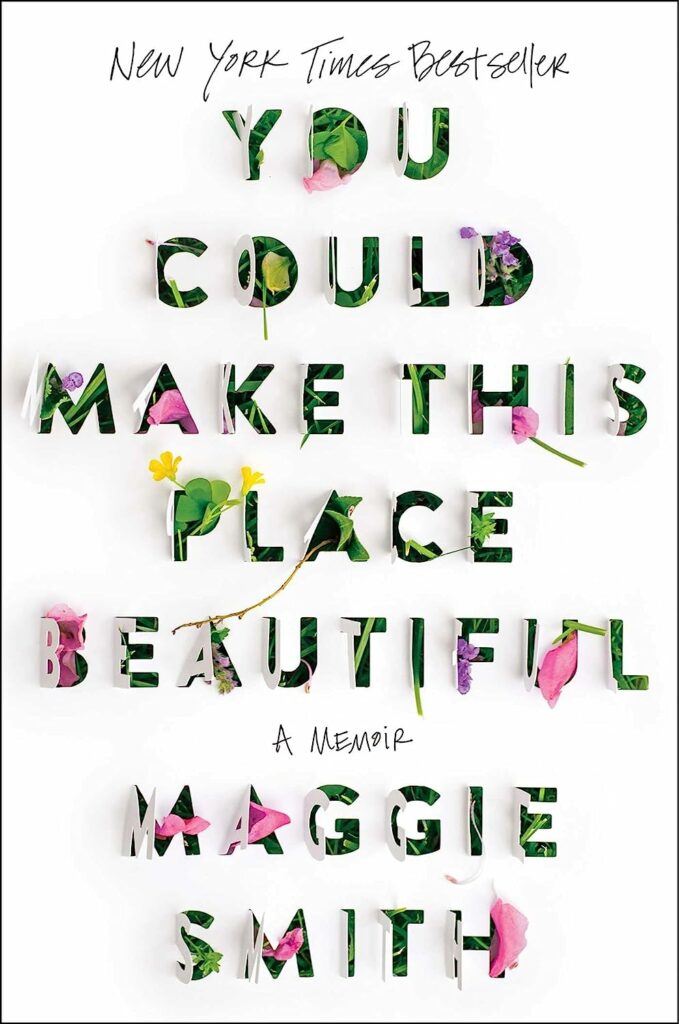Reviewed by Kait Walser
 Why write a memoir? There are countless reasons: to process, to archive, to forgive. To help others feel less alone, or to write until the beauty of your life reveals itself. Prolific author Maggie Smith journeys through all of this and more in her debut memoir, You Could Make This Place Beautiful (Atria, April 2023).
Why write a memoir? There are countless reasons: to process, to archive, to forgive. To help others feel less alone, or to write until the beauty of your life reveals itself. Prolific author Maggie Smith journeys through all of this and more in her debut memoir, You Could Make This Place Beautiful (Atria, April 2023).
Smith’s memoir examines different facets of her life—poet, mother, wife, divorcee—holding each to the light and casting their glow in the form of brief chapters. This book’s heartfelt prose and compelling narrative will speak to a wide range of readers. Crafted with deliberate constraint, her prose is as approachable as her viral social media posts and, of course, her poetry.
“Life, like a poem, is a series of choices,” Smith writes in You Could Make This Place Beautiful. The memoir’s title is a call to action taken from a line in her poem, “Good Bones,” which went viral in 2016. Published in Waxwing Magazine only days after the anti-queer Pulse nightclub massacre, this tenderly relentless poem resonated with America’s collective uncertainties during a tense election season. It also proved to be a catalyst for Smith’s career—which then shed light on tensions in her own marriage.
“The things we call ‘life-changing’ are and aren’t,” Smith writes in her memoir. “Meryl Streep can read your poem, and it can be in an episode of a prime-time TV show, but your life is still your life—mothering and dog walking and working.” These daily acts of care and quotidian—this series of choices, if you will—are the heartbeat and momentum of the book.
Everyday family interactions are punctuated by emotional contemplations and narrative revelations. These acts of mothering carry the reader forward, much like they did for the author when her life story took a new shape.
To categorize this as a book about divorce is reductive. Yes, the narrative is driven by vignettes of meditations on betrayal and a marriage undone. But it’s the revelatory self-discovery that compelled me to keep reading—or, as the author famously tweeted during her divorce, to keep moving.
“Marriages are co-created,” Smith writes. “Whatever ours looked like, we built that together. We inherited parts of it, too.” Rather than focus on blame, she approaches the story of her marriage and subsequent divorce with a sense of mutual accountability. “This isn’t the story of a good wife and a bad husband. Maybe this is the story of two human beings who committed to each other very young and didn’t survive one another’s changes.”
Repetition in chapter titles reflects a literary device seen recently in poetry, like a form of anaphora for titling. Each poem—or, in this case, each chapter—stands alone, but can be read in conversation with the other chapters of the same title. “Some People Ask” is one of Smith’s repeating chapters. These chapters take on an almost accusatory, sometimes protective tone that initially had me wondering what sort of thoughtless questions Smith was asked on tour. This is especially the case when she mentions her children.
In response to being asked if she thought her divorce made her children more resilient, Smith writes, “I could say their father said that once, that they’d be more resilient. I could say how angry I was about that, as if the divorce were a gift we were giving them.” She continues, “As if you have to break someone’s heart to make them strong. I could say you don’t get to take credit for someone’s growth if they grow as a result of what you put them through.” This fierce compassion gets stronger throughout the book—first when she writes of her children and, gradually, as she writes about herself.
“A Friend Says Every Book Begins with an Unanswerable Question” is another series of chapter titles, which invites readers into the writing process as Smith ruminates on why—and what—she is writing. For writers and readers alike, it’s a familiar inquiry.
“The question I keep asking myself as I write this book—the question I keep insisting upon—is this: how can this story—this experience—be useful to anyone other than me? How can I make this material into a tool that you can use?”
There’s nothing like witnessing another person catalog the closed chapters of their life to get you introspective. There were times when I set the book down to do an extra chore at home, suddenly conscious of how often I leave that specific responsibility to my husband. There were times when I set this book down to text my own mother and thank her for the thankless work she did to raise us kids after her own divorce. Which is to say: this memoir succeeds in taking raw emotion and tumbling it into a polished gemstone that reflects back the human experience.
Ultimately, this memoir reads as a love letter to the author’s children. Smith acknowledges that she can only tell her side of the story—of their shared family story.
Smith’s scenes form an archive of a mother’s beloved memories. She shares snippets of clever quotes and found poetry from conversations with her children. She crafts cinematic anecdotes of roller skating and kitchen dance parties with the kids.
“Music is my constant companion,” writes Smith. It’s evident in the ways she illustrates a shared relationship with concerts, playlists, and building family memories around music. Fellow audiophiles can add to their own reading experience by listening to a playlist the author created just for this memoir on Spotify—including a few songs mentioned in the book. Alternately, readers can opt for the audiobook to enjoy narration by the author. However you choose to experience it, You Can Make This Place Beautiful is an invitation to consider our past, present, and future with a sense of hope and possibility.
 Kait Walser is a New York City-based poet, copywriter and reviewer. Her recent work appears in the Indolent Books series Poems in the Afterglow and the anthology In Absentia: Reflections on the Pandemic (Bicycle Comics, 2020). Kait holds an MFA from Wilkes University, where she won the 2013 Etruscan Prize. She has facilitated workshops, curated, and hosted readings for Union Square Slam and At the Inkwell NYC. Photo by Heather Kresge.
Kait Walser is a New York City-based poet, copywriter and reviewer. Her recent work appears in the Indolent Books series Poems in the Afterglow and the anthology In Absentia: Reflections on the Pandemic (Bicycle Comics, 2020). Kait holds an MFA from Wilkes University, where she won the 2013 Etruscan Prize. She has facilitated workshops, curated, and hosted readings for Union Square Slam and At the Inkwell NYC. Photo by Heather Kresge.

